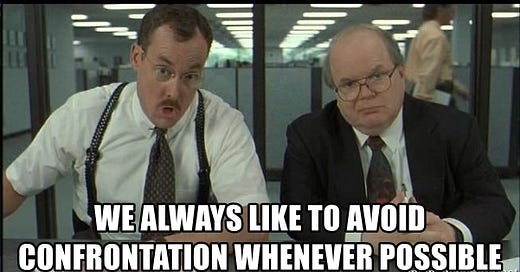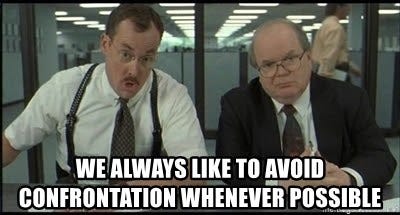“The fetishized life without friction”
What started as an emphasis on frictionless products has become an emphasis on frictionless employees.
I recently re-read Anna Wiener’s Uncanny Valley, a book which should be required reading for anyone working in the tech industry. Wiener’s experience of being a non-technical, female employee at an early stage startup is one that I deeply relate to (and I know the majority of my female peers agree). Of course, stories of sexism and nonexistent HR at startups are nothing new. But Wiener’s story cuts much deeper. She captures certain nuances of tech culture that I've never been able to articulate, but that have always left me with an icky feeling. She talks about how trust and safety measures are left by the wayside at many startups, and about how the analytics company she worked at measured success based on how “addicted” their users were. She also talks about all the times when she, a young female employee, was encouraged to turn a blind eye to the issues that arise when a bunch of 20-somethings are in charge of multi-million or billion dollar companies -- and making up their own rules. She talks about how she was told not to confront or escalate these problems.
Inspired by my rereading, I dug into more of Wiener’s work. I was drawn to her episode of the "Tech Won’t Save Us" podcast titled "The Frictionless World of Silicon Valley." Frictionlessness is my jam! In the operations world, friction is the enemy: handoffs, manual data entry, cognitive burdens, and misaligned incentives. Automation and strategic process design is all about reducing friction.
I learned about the tech industry's distaste for friction in my last startup ops role. The company had grown to a couple hundred people without much focus on internal operations or infrastructure. Bluntly, it was a bunch of sales people making up their own rules. As the second hire on the revenue operations team, I was tasked with whipping our processes into shape, documenting them, and rolling them out to the sales team. I was also solely responsible for driving adoption of any new software we implemented. This was my first exposure to the scary world of change management.
The members of the sales team were not excited about my suggested changes. They didn't want to log their opportunities or client meetings in our CRM. Hell, they didn't even remember their passwords to the CRM.
In webinars, online forums, and conferences, I was told that the resistance I faced was due to a lack of buy-in and “too much friction.” Forum comments suggested that, in order to get buy-in, I needed to collect and present data on how these changes would improve the sales team’s metrics. One commenter suggested I reduce the number of clicks it took to complete a given process. So, I click-optimized. I streamlined, whittled down, and automated. And yet, the sales team continued to rebel. Meanwhile, my team came under fire because our sales data was so bad we couldn't accurately forecast even a week or two ahead.
One day, I got a Slack message from a sales rep explaining that he closed a big deal that he had "totally forgotten" to enter into the system a few weeks back… and that the client wanted to close immediately… and that he was on the road for another client visit… and that if I didn't help him get the opportunity into Salesforce right that minute then the company would lose this six-figure deal.
I heard my manager’s voice in my head, reminding me that our team's primary mission was to help drive revenue. That sales reps were our customers. That we needed to do everything in our power to reduce friction.
So I entered the opportunity into our CRM myself, generated the quote, and sent it off to the customer. It only took a couple clicks (I thought proudly to myself).
Looking back, I'm embarrassed by this choice and a slew of similar ones that came along with it. But I was tired of arguing. I had spent months collecting user feedback, working with our engineering team, and QA testing our new opportunity entry flow to ensure that it required as few clicks as possible. I got into arguments with engineers who didn't understand why I needed them to spend tens of hours to make the flow mobile friendly. I was just trying to reduce friction.
Listening to Wiener’s podcast episode gave me a better perspective on the tech industry's obsession with frictionlessness. She explains that frictionless tech stems from the idea that it "should be as fast and as easy as possible to get you to whatever moment in a digital experience that generates revenue." A 2013 New Yorker article explains how FAANG companies declared war on friction essentially as a growth hacking strategy. In the tech world, a frictionless experience is one where the barriers between digital and physical are blurred (Postmates and Uber are prime examples). Frictionlessness implies convenience, which is an easy sell for overworked Americans. In fact, we are so bought in to the value of frictionlessness that we've convinced ourselves that making a phone call to order dinner or schedule a ride to the airport is out of the question.
Over the past decade, frictionlessness has become the defining principle of our online experiences. So much of what excites us at Automatter is based on creating more frictionless digital experiences. API-first tools (like Airtable) reduce friction by making it seamless to move data from one location to another. No-code tools (like Webflow) reduce the friction historically required to build software. Automation and workflow tools (like Zapier) reduce the friction of the manual work required to stay organized and productive.
But, as Wiener points out in the podcast episode, frictionlessness has permeated the culture of the tech industry. What started as an emphasis on frictionless products has become an emphasis on frictionless employees. Reflecting on my own experience, I realized that I was more interested in being perceived as frictionless than I was in addressing areas of inefficiency in the company’s processes. I thought being frictionless meant accepting the lack of accountability while simultaneously trying to conceal the operational problems it caused.
In an industry that is predicated on innovation, it seems absurd that young people are *still* encouraged to be frictionless. VC’s pride themselves on being contrarian, and yet the industry is still ruled by the same practices and principles that were established 40 years ago. And the lack of friction -- in our products, processes, and people -- has made it easier to cling to the status quo. If giving up my suite of no-code automation tools created more space to rethink and redesign the processes that define the venture industry, I would do it in a second. Maybe more friction -- more questions, slower processes, higher barriers to broadcasting every thought that comes to our minds -- is exactly what we need to break the status quo.






